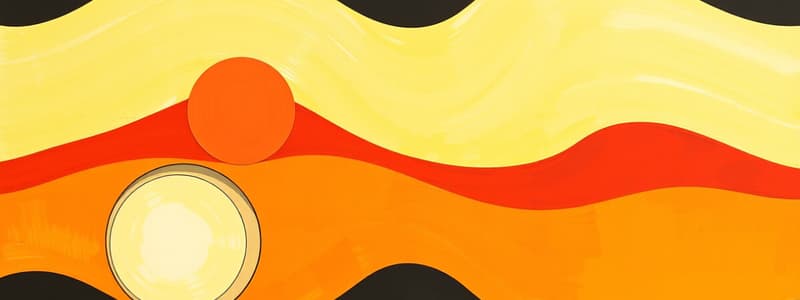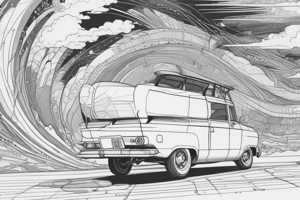Podcast
Questions and Answers
What is an actual shape?
What is an actual shape?
- A shape without a clear definition
- An irregular shape resembling living organisms
- A shape that appears related to geometry
- A positive area with clearly defined boundaries (correct)
What characterizes an amorphous shape?
What characterizes an amorphous shape?
A shape without a clear definition; formless and indistinct.
Define a biomorphic shape.
Define a biomorphic shape.
An irregular shape that resembles the freely developed curves found in living organisms.
What is Cubism?
What is Cubism?
Describe a curvilinear shape.
Describe a curvilinear shape.
What does decorative shape mean in art?
What does decorative shape mean in art?
What is equivocal space?
What is equivocal space?
Define a geometric shape.
Define a geometric shape.
What is an implied shape?
What is an implied shape?
What defines kinetic art?
What defines kinetic art?
What is mass in graphic art?
What is mass in graphic art?
What does objective art refer to?
What does objective art refer to?
Define perspective in art.
Define perspective in art.
What is a planar shape?
What is a planar shape?
Define a plane in art.
Define a plane in art.
What characterizes a plastic shape?
What characterizes a plastic shape?
What is a rectilinear shape?
What is a rectilinear shape?
What is the definition of shape in art?
What is the definition of shape in art?
Define a silhouette.
Define a silhouette.
What does subjective mean in art?
What does subjective mean in art?
What is surrealism?
What is surrealism?
Define three-dimensional in art.
Define three-dimensional in art.
What does two-dimensional refer to?
What does two-dimensional refer to?
What is void in art?
What is void in art?
Define volume in art.
Define volume in art.
Flashcards are hidden until you start studying
Study Notes
Shapes and Definitions
- Actual Shape: Clearly defined positive area with explicit boundaries.
- Amorphous Shape: Formless and indistinct shape lacking clear definition and dimension.
- Biomorphic Shape: Irregular shape that mimics the curves found in living organisms.
- Curvilinear Shape: Boundaries mainly consist of curved lines, contrasting with rectilinear shapes.
- Geometric Shape: Simple shapes related to geometry, like triangles, rectangles, and circles.
- Implied Shape: Suggested shape created by psychological connections between dots, lines, or areas.
- Rectilinear Shape: Defined by straight lines, opposite of curvilinear shapes.
- Planar Shape: Shapes having height and width, without thickness indication.
- Silhouette: The total shape emerging from the contours or edges of an object.
Artistic Movements and Terms
- Cubism: Painting style developed by Pablo Picasso and Georges Braque (1907-1912), using multiple views to create three-dimensionality on a two-dimensional surface, marking the start of abstract art.
- Surrealism: Art form influenced by Freudian psychology emphasizing fantasy and subconscious experiences through automatic techniques.
Art Concepts
- Decorative Shape: Enriches artwork, highlighting its two-dimensional nature.
- Equivocal Space: Intentionally ambiguous space allowing viewers to see various relationships within the artwork, akin to an optical illusion.
- Kinetic Art: Involves actual movement, derived from the Greek word 'kinesis'.
- Mass: Refers to three-dimensional shapes that stand out or create an illusion of solid material in graphic art, or physical bulk in plastic arts.
- Perspective: Graphical systems creating illusions of three-dimensionality or spatial relationships, depicting diminishing objects in the distance.
- Plastic Shape: Creates the illusion of three dimensions on a flat surface or refers to actual three-dimensional art forms.
Dimensions in Art
- Two-dimensional: Height and width dimensions, typically on flat surfaces.
- Three-dimensional: Depth, height, and width dimensions, with depth as a physical reality in plastic arts or an illusion in graphic arts.
- Volume: Defined measure of three-dimensional space.
Subjectivity in Art
- Objective Art: Closely reflects physical reality or optical perception; appears natural and real.
- Subjective Art: Derives from personal bias, emotion, or innovative interpretation, rather than strictly physical reality.
Space in Art
- Void: Lacking substance, consisting of negative space or spatial area penetrated by objects.
Studying That Suits You
Use AI to generate personalized quizzes and flashcards to suit your learning preferences.




